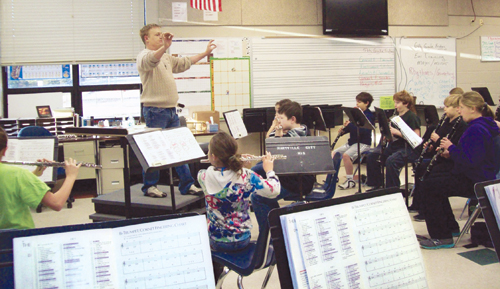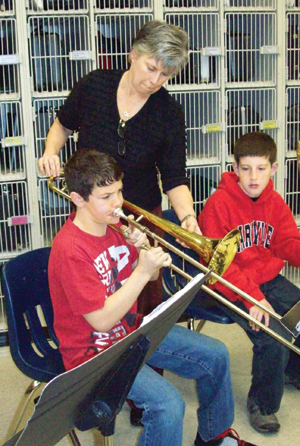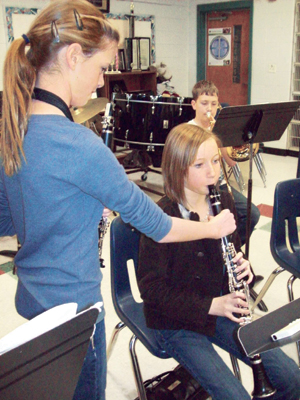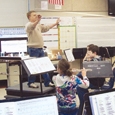
Good rehearsal techniques are the same for all ages. Perhaps the only difference between a beginning band rehearsal and a university band rehearsal is the difficulty of music. How a student plays an instrument and how the director puts everything together are similar in both situations.
Rehearsal Prep
Entering the classroom in a disorderly fashion or with too much socializing leads to poor music making. Students should enter the classroom with the correct degree of respect for learning and approach the upcoming rehearsal as their job. Students will need instruction on how to enter the room and may need reminders until it becomes habitual. Placement of lockers can separate the business and social aspects of band. Students benefit from social time to interact with each other and create the family bond in the band, but lockers should be separate from the rehearsal area if possible. When students enter the instrumental section this should create an immediate response of work related habits. There should be some excitement in the room, but it should be about making music.
It is best for students to enter the room and immediately prepare for the rehearsal. This includes assembling instruments and accessories, retrieving a tuner from the classroom set, making sure they have a pencil, and preparing a music stand by adjusting it to the correct height and placing music in order as it is listed on the board. A section on the board for announcements should include the guideline for the day’s rehearsal. This gives students an opportunity to organize the selected music accordingly and begin practicing those spots before rehearsal begins. This eliminates the need to discuss what is happening that day. Instruction should be as specific as possible; rather than just listing pieces to be rehearsed, include what parts of the piece and specific aspects of musicianship that will be covered.
The physical setup of the rehearsal room, including everything from chair set-up to the placement of storage lockers and podium position, directly affects rehearsal techniques. Supply a stand for each student. This allows students to spread out and forces them to be responsible for their own music, part, and sound. It also gives everybody room for a fingering chart, pencil, tuner, and mirror. Students’ bodies will act as mutes if they are too close together. Students need ample room to play the instrument correctly and for the sound to resonate. Pitch, dynamics, overall phrasing, balance, and listening skills are affected by the chair set-up. The percussion section creates the pulse and rhythm of the ensemble, and placement of percussion equipment will demonstrate to the ensemble whether the percussion section is significant. Provide enough room for each percussive instrument and place the instruments accordingly; timpani should be close to tubas, bass drum and snare close to the low brass, keyboard percussion closer to the woodwinds. Do not bury the section in the back of the room.
We have student leaders check their section to make sure that each student has a chair, stand, tuner, and pencil. Other students begin an appropriate individual warm up and practice. Students are accountable to each other and take pride in how their section operates. All classroom logistics, procedures and rituals are designed to enhance the music, not the social. Directors should permit students to have sufficient time to set up and warm up without letting procrastinators slow things down.
A director’s expectations determine the response and respect of the students toward rehearsals. Decide in advance what students should do when you are on and off the podium. The example of a military sergeant building his troops to handle every possible scenario can be a good analogy for on the podium. When the director is off the podium, develop leadership, responsibility, and thinking skills. With explicit expectations, students will perceive the rehearsal as a business-like environment, and there will be more fruitful rehearsals and fewer discipline problems.
Warm-Up and Tuning
We teach students that the instant the conductor’s foot hits the podium the room is to be absolutely silent and still. We simply point to the first clarinet player who plays a concert F, a signal for students to cease all movement, sit correctly on the edge of the chair with both feet flat on the floor, place the instrument to the face, set the embouchure, breathe, and then match pitch upon the director’s downbeat. Beginning instruction time with a tuning note is a better way to get students to focus than pleading and nagging.
In a 45-minute class period, we may warm up, tune, and work on getting a characteristic band sound for at least 20 minutes. Many directors believe the purpose of warming up is merely to warm the instrument, so they have students doodle on the instrument for a few minutes. The warm-up should be like a choir, which will warm up on syllables and spend a great deal of time working on balance and blend. We define the warmup as time for students to recall pitch, tuning characteristics, blending in the section, balance among the other instruments, and ensemble sound. Spend time helping students recall how you want entrances and releases, dynamics, accents, and articulations, especially within the band sound.
Initially, we hold concert F for a minute with the beginning band, two minutes with our sixth grade band, and three minutes with the advanced sixth grade wind ensemble. We train students to enter and exit the F with only minute changes in the embouchure and no audible fluctuations in pitch. Students are trained to know their instrument pitch tendencies. Barrels, headjoints, reeds, mouthpieces, necks and tuning slides are kept consistent from day to day and rarely moved from their designated places. This way students learn to tune as they play the instrument. They must be able to correct pitch in the heat of battle rather than by pushing and pulling on the instrument all the time.
Because we tune to concert F, we will usually play the F scale in unison and sometimes in thirds. Scales should start slowly with no set tempo to teach students to watch the director. Next, play with a pulse, but with rubato, then with metronome and articulations. To vary things, play a single scale overlapping among instruments, then two scales overlapping. Although we play the F scale daily, we also play the scale of the selection that is to be played first. Include rhythms of the selection in warm-up scales. After scale work, we use chords and chorales to help establish blend and balance.
We check pitch of instruments only after warming up for 20 minutes. This means the band will not be in tune at the beginning of the warm-up. We tune the bottom of the band, then make sure the top of the band is listening and matching. Section leaders especially should listen across the band to each other. A variety of tuning exercises can be used. We check flutes on an F in octaves followed by the first five notes of the Bb scale to check tonehole placement. Clarinets play an open G, ascend up to C, then keep going up to G5, followed by C6. Saxophones play written F# and check D to see if students can adjust within the section. Brass players work on lip slurs or chromatic exercises.
Determine which section is matching pitch the least and take the time to fix this by asking that section to match pitch. Do not tune one player at a time; this is a shot in the dark and a waste of precious minutes. Students tune better and more quickly with a pitch to match. You may have to go down the line adding one instrument at a time, requiring them to match their leader, their tuner and their neighbor.
Pay close attention to the tonguing and to the entrances and releases during warmups. Do not wait until working on music to demand that students play with a characteristic sound, blend, and balance.
 Individual Instrumental Coaching
Individual Instrumental Coaching Each student should play alone each day for the instructor to remedy any playing concerns. This can be an assigned test or quick chair audition, but every student should receive advice on how to play better each day. It is a waste of time to tell students to practice without showing them how to practice. Fingering the correct note will not create music.
Telling a student to sit up just because it is right and looks good is fine, but when students hear their sound improve, then the sound becomes your proof that your instruction is true and beneficial. When you correct someone in rehearsal, allow the student and other students to hear that your advice made a difference, and then praise the student exceedingly.
Students should know what kind of tonguing you want. The brass players use a da tongue generally, switching to la if more legato is needed and to ta for crisp articulations. Woodwinds use the syllable doo. Other things students should know are where you want the tongue placement for each instrument, what kind of sound you want from each instrument, and which sections ought to use vibrato and how much. Students will need to learn what to do with the stomach, mouth, lips, tongue, teeth, shoulders, neck, toes, back, wrists, and fingers to be able to do these things. We withhold no information; intonation skills, flaws of the instruments, alternate fingerings, and appropriate vibrato are all explained.
Never forget to praise students for what they do well, especially when they are successful at adopting suggested changes. While you work with a woodwind player, the other woodwinds should pay attention to the advice you give while the brass players study and finger passages to prepare for the rehearsal. The reverse is true when working with the brass. Every student should be engaged at all times.
Rehearsing the Music
Be sure to play the scale applicable to the piece or passage you intend to rehearse. Play thirds and any other intervals and chords that will get students’ ears accustomed to that key. Many directors get entirely too caught up in teaching the notes and rhythms, but students will eventually get these. It is more beneficial to address all of the physical elements of playing the instrument correctly when teaching the music. Rather than re-teaching students how to count sixteenth notes, or even worse, singing a passage to them, tell students what you want their tongues to do to make the notes speak correctly. Coach by addressing the fundamentals of the instrument.
When rehearsing the music, ask for large portions of the music to be tongued on one note; we usually use the tonic. Using one note eliminates the need to worry about fingerings, and leaves room to work on sound, breathing, pitch, articulations, and balance within the section and in the ensemble. After students can do this well, have certain sections play the music as written while others play the rhythms on tonic. Students will be jumping out of their seats wanting to play all the notes.
Directors should do a chord analysis for works they rehearse. Break the band into four groups to balance chords at key places in the composition. At each rehearsal square or other important places in the chord progression, sustain the chord long enough for students to find good balance and tuning. For instance, we divide the band into four groups. Group one is composed of the tubas, baritone sax, bassoon, and bass clarinet; group two members are the trombones, euphoniums, horns, and tenor saxophones; group three is the trumpets, alto saxophones, and the 2nd and 3rd clarinets; and group four is composed of flutes, oboes, and 1st clarinets. When the sound is satisfactory, use that chord to play from one rehearsal marker to the next.
This works with other aspects of music as well. A common misconception is that everyone must accent when the music says to do so. This is incorrect. Assign certain students to accent notes when written and keep others just moving air through the instrument. This will preserve the balance and tone of the music.
Break down all the instrumental skills that will be needed to successfully play and perform a particular piece of music. Students do not know the details of what it takes to play their instruments well in an ensemble. Tuba players must tongue slightly ahead of entire ensemble to be together, and trombonists must move the arm and elbow ahead of the tongue. Low reed players should have an extremely fast airstream and excellent reeds. If they are not tonguing well, check to see what reed and mouthpiece combination they are using. Brass players should explore the tessitura of a particular line often to learn what the muscles in their mouth and ear should do for a particular passage. The best way to do this is by having them buzz their mouthpiece often.
Any necessary alternate fingerings will have to be pointed out and taught, and the trombones are likely to need time to find each note position. Other obstacles include crossing the break, unusual finger combinations, flawed notes that need special attention to tuning, and unusual skips in the tessitura for the brass. Work the skills of the piece more than the piece itself. Run-throughs do not give the students the information they need or the education they deserve.
Peer Teaching and Leadership
 Students should be involved in each other’s success and trained to listen to and diagnose both their playing and that of their classmates. Section leaders may at any time stand up and move through their section correcting skills they see and hear not properly performed. Even in fifth and sixth grade, we expect section leaders to be in their seats for only about 40% of the class period. It takes a while for students to know how to do this. For weeks you will have to instruct them to find the member of the section that is not matching pitch, tapping their toes, tonguing in the right spot, using vibrato (flutes) or breathing and blowing correctly. The list of things to check is long. After a few weeks, they will be comfortable enough to do this without prodding, and suddenly you will have a dozen assistant band directors in the room. The smarter your band becomes, the better their performance skills will be.
Students should be involved in each other’s success and trained to listen to and diagnose both their playing and that of their classmates. Section leaders may at any time stand up and move through their section correcting skills they see and hear not properly performed. Even in fifth and sixth grade, we expect section leaders to be in their seats for only about 40% of the class period. It takes a while for students to know how to do this. For weeks you will have to instruct them to find the member of the section that is not matching pitch, tapping their toes, tonguing in the right spot, using vibrato (flutes) or breathing and blowing correctly. The list of things to check is long. After a few weeks, they will be comfortable enough to do this without prodding, and suddenly you will have a dozen assistant band directors in the room. The smarter your band becomes, the better their performance skills will be. We tell section leaders that they are responsible for the performance of their sections. One of the hardest things to teach leaders is how to praise their peers. Being critical is difficult at first, but the students will learn how to correct each other. Praising, bragging, smiling, and pats on the back are often more difficult for young students. You will have to model this with praise that is frequent, creative, and sincere.
To keep all students paying attention, ask questions that require them to think about their skills. Students should learn to identify and solve problems on their instruments. A clarinetist who cannot tongue at a tempo of q = 112 should know enough to wonder whether the reed is too heavy, thin, or old. He should check whether he is pushing enough air for the reed to respond or taking in enough mouthpiece. Students who know enough to fix their playing find band much more enjoyable. All students should be asked for solutions in a rehearsal. The teacher should not provide all the answers. This is boring and telling students what to do all the time will make them into unthinking robots. Ask such questons as “What was the last sound you heard?” “What is supposed to be the last sound you heard?” “Which section is dragging?” “Who is rushing?” “How can the clarinets fix their note A?” “Did it sound like the trumpets used their 3rd slide or did they
forget?”
Closing
Study the score as a director and as a player. Define the skills necessary to play the piece of music and coach the physical elements of performing to your students. The best bands focus on the future. These ensembles practice all scales daily, devote plenty of time to warmups, and encourage, if not require, students to take private lessons. It will take longer than a few weeks to teach mouth placement, tongue placement, hand position, and other elements of musicianship. Band pieces should be used to teach these topics. This knowledge then transfers to other music selections and builds over the years to a higher level of performance and sightreading.





